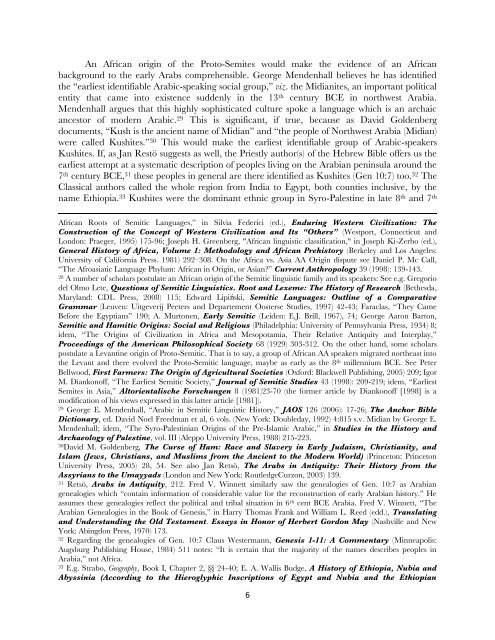Muhammad_Article.349.. - Dr. Wesley Muhammad
Muhammad_Article.349.. - Dr. Wesley Muhammad
Muhammad_Article.349.. - Dr. Wesley Muhammad
You also want an ePaper? Increase the reach of your titles
YUMPU automatically turns print PDFs into web optimized ePapers that Google loves.
An African origin of the Proto-Semites would make the evidence of an African<br />
background to the early Arabs comprehensible. George Mendenhall believes he has identified<br />
the “earliest identifiable Arabic-speaking social group,” viz. the Midianites, an important political<br />
entity that came into existence suddenly in the 13 th century BCE in northwest Arabia.<br />
Mendenhall argues that this highly sophisticated culture spoke a language which is an archaic<br />
ancestor of modern Arabic. 29 This is significant, if true, because as David Goldenberg<br />
documents, “Kush is the ancient name of Midian” and “the people of Northwest Arabia (Midian)<br />
were called Kushites.” 30 This would make the earliest identifiable group of Arabic-speakers<br />
Kushites. If, as Jan Restö suggests as well, the Priestly author(s) of the Hebrew Bible offers us the<br />
earliest attempt at a systematic description of peoples living on the Arabian peninsula around the<br />
7 th century BCE, 31 these peoples in general are there identified as Kushites (Gen 10:7) too. 32 The<br />
Classical authors called the whole region from India to Egypt, both counties inclusive, by the<br />
name Ethiopia. 33 Kushites were the dominant ethnic group in Syro-Palestine in late 8 th and 7 th<br />
African Roots of Semitic Languages,” in Silvia Federici (ed.), Enduring Western Civilization: The<br />
Construction of the Concept of Western Civilization and Its “Others” (Westport, Connecticut and<br />
London: Praeger, 1995) 175-96; Joseph H. Greenberg, "African linguistic classification," in Joseph Ki-Zerbo (ed.),<br />
General History of Africa, Volume 1: Methodology and African Prehistory (Berkeley and Los Angeles:<br />
University of California Press. 1981) 292–308. On the Africa vs. Asia AA Origin dispute see Daniel P. Mc Call,<br />
“The Afroasiatic Language Phylum: African in Origin, or Asian?” Current Anthropology 39 (1998): 139-143.<br />
28 A number of scholars postulate an African origin of the Semitic linguistic family and its speakers: See e.g. Gregorio<br />
del Olmo Lete, Questions of Semitic Linguistics. Root and Lexeme: The History of Research (Bethesda,<br />
Maryland: CDL Press, 2008) 115; Edward Lipiński, Semitic Languages: Outline of a Comparative<br />
Grammar (Leuven: Uitgeverij Peeters and Departement Oosterse Studies, 1997) 42-43; Faraclas, “They Came<br />
Before the Egyptians” 190; A. Murtonen, Early Semitic (Leiden: E.J. Brill, 1967), 74; George Aaron Barton,<br />
Semitic and Hamitic Origins: Social and Religious (Philadelphia: University of Pennsylvania Press, 1934) 8;<br />
idem, “The Origins of Civilization in Africa and Mesopotamia, Their Relative Antiquity and Interplay,”<br />
Proceedings of the American Philosophical Society 68 (1929) 303-312. On the other hand, some scholars<br />
postulate a Levantine origin of Proto-Semitic. That is to say, a group of African AA speakers migrated northeast into<br />
the Levant and there evolved the Proto-Semitic language, maybe as early as the 8 th millennium BCE. See Peter<br />
Bellwood, First Farmers: The Origin of Agricultural Societies (Oxford: Blackwell Publishing, 2005) 209; Igor<br />
M. Diankonoff, “The Earliest Semitic Society,” Journal of Semitic Studies 43 (1998): 209-219; idem, “Earliest<br />
Semites in Asia,” Altorientalische Forschungen 8 (1981)23-70 (the former article by Diankonoff [1998] is a<br />
modification of his views expressed in this latter article [1981]).<br />
29 George E. Mendenhall, “Arabic in Semitic Linguistic History,” JAOS 126 (2006): 17-26; The Anchor Bible<br />
Dictionary, ed. David Noel Freedman et al, 6 vols. (New York: Doubleday, 1992) 4:815 s.v. Midian by George E.<br />
Mendenhall; idem, “The Syro-Palestinian Origins of the Pre-Islamic Arabic,” in Studies in the History and<br />
Archaeology of Palestine, vol. III (Aleppo University Press, 1988) 215-223.<br />
30 David M. Goldenberg, The Curse of Ham: Race and Slavery in Early Judaism, Christianity, and<br />
Islam (Jews, Christians, and Muslims from the Ancient to the Modern World) (Princeton: Princeton<br />
University Press, 2005) 28, 54. See also Jan Retsö, The Arabs in Antiquity: Their History from the<br />
Assyrians to the Umayyads (London and New York: RoutledgeCurzon, 2003) 139.<br />
31 Retsö, Arabs in Antiquity, 212. Fred V. Winnett similarly saw the genealogies of Gen. 10:7 as Arabian<br />
genealogies which “contain information of considerable value for the reconstruction of early Arabian history.” He<br />
assumes these genealogies reflect the political and tribal situation in 6 th cent BCE Arabia. Fred V. Winnett, “The<br />
Arabian Genealogies in the Book of Genesis,” in Harry Thomas Frank and William L. Reed (edd.), Translating<br />
and Understanding the Old Testament. Essays in Honor of Herbert Gordon May (Nashville and New<br />
York: Abingdon Press, 1970) 173.<br />
32 Regarding the genealogies of Gen. 10:7 Claus Westermann, Genesis 1-11: A Commentary (Minneapolis:<br />
Augsburg Publishing House, 1984) 511 notes: “It is certain that the majority of the names describes peoples in<br />
Arabia,” not Africa.<br />
33 E.g. Strabo, Geography, Book I, Chapter 2, §§ 24-40; E. A. Wallis Budge, A History of Ethiopia, Nubia and<br />
Abyssinia (According to the Hieroglyphic Inscriptions of Egypt and Nubia and the Ethiopian<br />
6

















